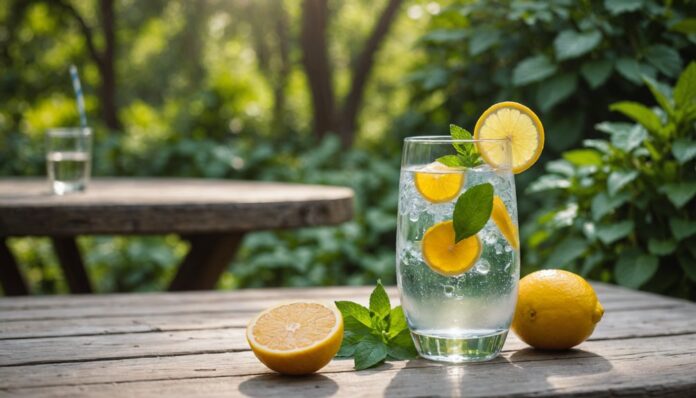Staying hydrated during warmer months is a top priority for maintaining overall health and energy levels. As temperatures rise, the body loses crucial fluids through sweating, making it essential to replenish them effectively. With various hydration options available, choosing the right drinks and adopting smart hydration habits can make all the difference in preventing dehydration. But what are the safest ways to stay hydrated, and how can one avoid common pitfalls?
Highlights
- Prioritize hydration during outdoor activities in warmer months to optimize performance and health.
- Drink water or electrolyte-rich beverages before, during, and after activities to replenish fluids.
- Monitor urine color and output to gauge hydration levels and avoid dehydration.
- Choose healthy beverages like water, low-sugar sports drinks, and electrolyte-rich drinks to reduce dehydration risk.
- Store drinking water in clean, covered containers and purify water using methods like boiling, filters, or chlorine to ensure safety.
Choosing the Right Drinks for Hydration
When it comes to staying hydrated, not all drinks are created equal. Choosing the right beverages is vital, especially during warmer months.
Healthy beverage options, such as water, low-sugar sports drinks, and electrolyte-rich drinks like coconut water or herbal teas, are ideal for replenishing lost fluids and electrolytes.
Electrolyte-rich drinks are particularly beneficial for individuals who engage in strenuous physical activities or experience excessive sweating. These drinks help maintain a healthy balance of essential minerals like sodium, potassium, and calcium.
By opting for these healthy beverages, individuals can stay properly hydrated, reduce the risk of dehydration, and maintain overall well-being.
How to Avoid Waterborne Illnesses
Proper hydration relies not only on choosing the right beverages, but also on guaranteeing the water one drinks is safe and free from contaminants. Contaminated water can lead to waterborne illnesses, which can be severe and even life-threatening.
To avoid such illnesses, individuals can take steps to purify their drinking water. Water purification methods include boiling, using water filters, and disinfecting with chlorine or iodine.
Additionally, safe storage of drinking water is essential to prevent contamination. Water should be stored in clean, covered containers and kept away from potential sources of contamination, such as chemicals and waste.
Recognizing and Treating Dehydration Symptoms
As the body loses more fluids than it takes in, dehydration can set in, potentially leading to serious health consequences if not promptly addressed.
It is essential to recognize dehydration signs to initiate hydration recovery. Mild dehydration symptoms include headaches, dry mouth, and fatigue, while severe dehydration can cause dizziness, rapid heartbeat, and low blood pressure.
Individuals experiencing dehydration should drink plenty of water or electrolyte-rich beverages to replenish lost fluids. Resting in a cool, shaded area can also aid in hydration recovery.
In severe cases, medical attention may be necessary to prevent long-term damage. Monitoring urine output and color can also help identify dehydration, as dark or infrequent urination can indicate insufficient hydration.
Prompt recognition and treatment of dehydration are imperative for a swift recovery.
Smart Hydration Habits for Outdoor Activities
Engaging in outdoor activities during warmer months requires careful consideration of hydration strategies to maintain ideal health and performance. Individuals participating in sports, hiking, or gardening need to prioritize hydration to account for excessive fluid loss due to increased temperatures and physical exertion.
Effective hydration strategies include drinking water or electrolyte-rich beverages before, during, and after outdoor activities. Monitoring urine color and output can help gauge hydration levels.
Additionally, incorporating hydrating foods like fruits, vegetables, and broth-based meals can supplement fluid intake. By adopting these smart hydration habits, individuals can optimize their performance and enjoy the outdoors without compromising their health.
Adequate hydration is essential for physical comfort and reducing the risk of dehydration.
Common Hydration Mistakes to Watch Out For
While staying hydrated is a top priority during warmer months, many individuals inadvertently make mistakes that can hinder their hydration efforts. One common mistake is overhydration, which can lead to serious health risks, including hyponatremia. It is crucial to be mindful of overhydration risks and drink fluids in moderation.
Another mistake is believing in hydration myths, such as the notion that individuals must drink at least eight glasses of water a day. This myth has been debunked, and experts recommend drinking when thirsty, rather than adhering to a strict quota.
Conclusion
Staying hydrated during warmer months is an essential aspect of maintaining overall health and well-being. By choosing the right drinks, avoiding waterborne illnesses, recognizing dehydration symptoms, and adopting smart hydration habits, individuals can enjoy the season with minimal risk. By being mindful of common hydration mistakes and prioritizing safe hydration practices, people can protect themselves from dehydration and maintain their energy levels throughout the warmer months. Proper hydration enables everyone to make the most of the season.


